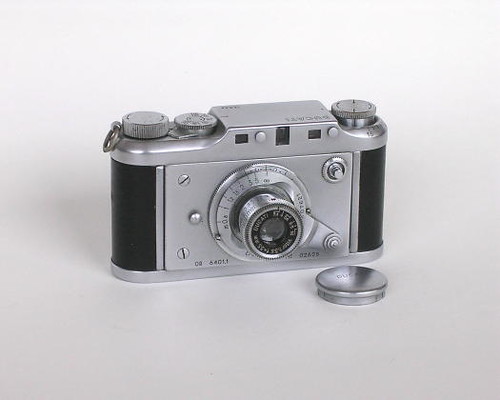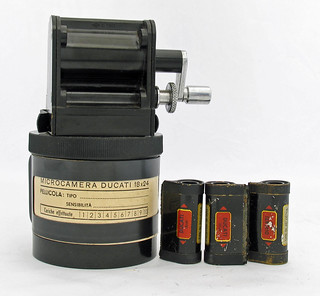Difference between revisions of "Sogno"
m (typo) |
m (Updated Espacenet refs for their new url form; short form for reused named refs) |
||
| Line 9: | Line 9: | ||
}} | }} | ||
</div> | </div> | ||
| − | The '''Sogno''' (Italian: 'dream') is a half-frame 35 mm coupled-rangefinder camera, made by [[Ducati]] in about 1950.<ref name=W>[https://wlpa.auction2000.se/auk/w.Object?inC=WLPA&inA=21&inO=495 Sogno] serial no. 09365, with 35 mm f/2.8 Vitor, offered at the [https://wlpa.auction2000.se/auk/w.ObjectList?inSiteLang=&inC=WLPA&inA=21 21st Westlicht Photographica Auction], on 23 May 2012.</ref><ref name=McK>{{McKeown12}} p252.</ref> It makes 18x24 mm pictures on 35 mm film, held in special cassettes, which are considerably slimmer than standard 135 cassettes.<ref>[http://www.philaphoto.com/imageLibrary/displayimage.php?album=129&pos=13 Ducati film cassettes] at [http://www.philaphoto.com/imageLibrary/index.php Phil Aynsley Photography]; there are also pictures of other [http://www.philaphoto.com/imageLibrary/thumbnails.php?album=129 Ducati cameras and accessories].</ref><ref>[ | + | The '''Sogno''' (Italian: 'dream') is a half-frame 35 mm coupled-rangefinder camera, made by [[Ducati]] in about 1950.<ref name=W>[https://wlpa.auction2000.se/auk/w.Object?inC=WLPA&inA=21&inO=495 Sogno] serial no. 09365, with 35 mm f/2.8 Vitor, offered at the [https://wlpa.auction2000.se/auk/w.ObjectList?inSiteLang=&inC=WLPA&inA=21 21st Westlicht Photographica Auction], on 23 May 2012.</ref><ref name=McK>{{McKeown12}} p252.</ref> It makes 18x24 mm pictures on 35 mm film, held in special cassettes, which are considerably slimmer than standard 135 cassettes.<ref>[http://www.philaphoto.com/imageLibrary/displayimage.php?album=129&pos=13 Ducati film cassettes] at [http://www.philaphoto.com/imageLibrary/index.php Phil Aynsley Photography]; there are also pictures of other [http://www.philaphoto.com/imageLibrary/thumbnails.php?album=129 Ducati cameras and accessories].</ref><ref>[https://worldwide.espacenet.com/patent/search?q=pn%3DGB657311A British Patent 657311] (first applied for in 1947, and granted in 1951 to Società Scientifica Radio Brevetti Ducati), ''Improvements in means for loading film cartridges or magazines with film to be used in photographic cameras'', describing a daylight cassette-loader for Ducati cassettes, at [http://worldwide.espacenet.com/ Espacenet], the patent search facility of the European Patent Office.</ref> It has a focal-plane shutter, with speeds 1/20 to 1/500 second, plus 'B'. Rick Oleson notes that the shutter is designed differently from that of a Leica; the gap between the two blinds is fixed, but their speed of travel is varied, by varying the spring tension driving them.<ref name=RO>[http://rick_oleson.tripod.com/index-17.html Ducati Sogno] notes at [http://rick_oleson.tripod.com/index-18.html Rick Oleson's website].</ref><ref>[https://worldwide.espacenet.com/patent/search?q=pn%3DGB657620A British Patent 657620] (again applied for in 1947 and granted in 1951), ''Improved single blind roller-blind shutter for photographic cameras'', at Espacenet.</ref> The shutter is not designed to be synchronised for flash, but examples exist which have been modified to add synchronisation.<ref>[http://www.philaphoto.com/imageLibrary/displayimage.php?album=129&pos=1 Sogno with added PC socket] at Phil Aynsley Photography.</ref> As a result of the fixed (and wide) shutter-gap design, this modification gives synchronisation at all speeds.<ref name=RO/> The fixed gap also means the shutter gap needs to be covered during cocking. This is done with a pair of metal blinds in front of the shutter.<ref name=RO/> The patent for this mechanism describes it with reference to another advantage; the metal blinds prevent damage to the cloth shutter from sunlight focused on it by the lens.<ref>[https://worldwide.espacenet.com/patent/search?q=pn%3DGB651221A British Patent 651221] (applied for in 1946, granted 1951), ''Improvements in means for protecting roller blind shutters in photographic cameras'', at Espacenet.</ref> |
{{Flickr_image | {{Flickr_image | ||
|image_source= https://www.flickr.com/photos/60780628@N08/6922381923/in/pool-camerawiki | |image_source= https://www.flickr.com/photos/60780628@N08/6922381923/in/pool-camerawiki | ||
| Line 20: | Line 20: | ||
| − | The viewfinder and rangefinder are in separate eyepieces. There is dioptric adjustment (the lever under the shutter speed dial).<ref name=RO | + | The viewfinder and rangefinder are in separate eyepieces. There is dioptric adjustment (the lever under the shutter speed dial).<ref name=RO/> The rangefinder is also the subject of a patent by Ducati; the moving element is not a rotating mirror, but a set of three lenses, only the middle element of which is moved; the patent claims the design is more accurate than other similar lens-based rangefinders, and does not vary the magnification of the second image in the RF.<ref>[https://worldwide.espacenet.com/patent/search?q=pn%3DGB649142A British Patent 649142] (applied for 1946, granted 1951), ''Improvements in range-finders or telemeters, more particularly for photographic purposes'', at Espacenet.</ref> |
The standard lens is a collapsible, coated 35 mm f/3.5 or f/2.8 '''Vitor''', focusing to 0.8 metre. This is interchangeable, with a bayonet fitting. Other lenses made for the Sogno include: | The standard lens is a collapsible, coated 35 mm f/3.5 or f/2.8 '''Vitor''', focusing to 0.8 metre. This is interchangeable, with a bayonet fitting. Other lenses made for the Sogno include: | ||
* '''Dugon''' 19 mm f/6.3<ref name=wides>[http://www.philaphoto.com/imageLibrary/displayimage.php?album=129&pos=6 Wide and standard lenses] at Phil Aynsley Photography.</ref> | * '''Dugon''' 19 mm f/6.3<ref name=wides>[http://www.philaphoto.com/imageLibrary/displayimage.php?album=129&pos=6 Wide and standard lenses] at Phil Aynsley Photography.</ref> | ||
| − | * '''Argon''' 28 mm f/4<ref name=wides | + | * '''Argon''' 28 mm f/4<ref name=wides/> |
* '''Eltor''' 40 mm f/2<ref name=teles>[http://www.philaphoto.com/imageLibrary/displayimage.php?album=129&pos=5 Long-focus lenses] at Phil Aynsley Photography.</ref> | * '''Eltor''' 40 mm f/2<ref name=teles>[http://www.philaphoto.com/imageLibrary/displayimage.php?album=129&pos=5 Long-focus lenses] at Phil Aynsley Photography.</ref> | ||
| − | * '''Lator''' 60 mm f/2.8<ref name=teles | + | * '''Lator''' 60 mm f/2.8<ref name=teles/> |
| − | * '''Teletor''' 120 mm f/5.6<ref name=teles | + | * '''Teletor''' 120 mm f/5.6<ref name=teles/> |
Viewfinder accessories were available to serve these lenses, some fitting to the studs on the top housing.<ref>[http://www.philaphoto.com/imageLibrary/displayimage.php?album=129&pos=4 Sogno with Teletor 120 mm lens and accessory viewfinder] at Phil Aynsley Photography.</ref><ref>[http://www.philaphoto.com/imageLibrary/displayimage.php?album=129&pos=3 Sogno with Dugon 19 mm lens and accessory frame-finder] at Phil Aynsley Photography.</ref> | Viewfinder accessories were available to serve these lenses, some fitting to the studs on the top housing.<ref>[http://www.philaphoto.com/imageLibrary/displayimage.php?album=129&pos=4 Sogno with Teletor 120 mm lens and accessory viewfinder] at Phil Aynsley Photography.</ref><ref>[http://www.philaphoto.com/imageLibrary/displayimage.php?album=129&pos=3 Sogno with Dugon 19 mm lens and accessory frame-finder] at Phil Aynsley Photography.</ref> | ||
Revision as of 08:27, 31 July 2020

|
| Sogno image by Rick Oleson (Image rights) |
The Sogno (Italian: 'dream') is a half-frame 35 mm coupled-rangefinder camera, made by Ducati in about 1950.[1][2] It makes 18x24 mm pictures on 35 mm film, held in special cassettes, which are considerably slimmer than standard 135 cassettes.[3][4] It has a focal-plane shutter, with speeds 1/20 to 1/500 second, plus 'B'. Rick Oleson notes that the shutter is designed differently from that of a Leica; the gap between the two blinds is fixed, but their speed of travel is varied, by varying the spring tension driving them.[5][6] The shutter is not designed to be synchronised for flash, but examples exist which have been modified to add synchronisation.[7] As a result of the fixed (and wide) shutter-gap design, this modification gives synchronisation at all speeds.[5] The fixed gap also means the shutter gap needs to be covered during cocking. This is done with a pair of metal blinds in front of the shutter.[5] The patent for this mechanism describes it with reference to another advantage; the metal blinds prevent damage to the cloth shutter from sunlight focused on it by the lens.[8]

|
| film cassette loading facility image by Peter Kitchingman (Image rights) |
The viewfinder and rangefinder are in separate eyepieces. There is dioptric adjustment (the lever under the shutter speed dial).[5] The rangefinder is also the subject of a patent by Ducati; the moving element is not a rotating mirror, but a set of three lenses, only the middle element of which is moved; the patent claims the design is more accurate than other similar lens-based rangefinders, and does not vary the magnification of the second image in the RF.[9]
The standard lens is a collapsible, coated 35 mm f/3.5 or f/2.8 Vitor, focusing to 0.8 metre. This is interchangeable, with a bayonet fitting. Other lenses made for the Sogno include:
- Dugon 19 mm f/6.3[10]
- Argon 28 mm f/4[10]
- Eltor 40 mm f/2[11]
- Lator 60 mm f/2.8[11]
- Teletor 120 mm f/5.6[11]
Viewfinder accessories were available to serve these lenses, some fitting to the studs on the top housing.[12][13]
Notes
- ↑ Sogno serial no. 09365, with 35 mm f/2.8 Vitor, offered at the 21st Westlicht Photographica Auction, on 23 May 2012.
- ↑ McKeown, James M. and Joan C. McKeown's Price Guide to Antique and Classic Cameras, 12th Edition, 2005-2006. USA, Centennial Photo Service, 2004. ISBN 0-931838-40-1 (hardcover). ISBN 0-931838-41-X (softcover). p252.
- ↑ Ducati film cassettes at Phil Aynsley Photography; there are also pictures of other Ducati cameras and accessories.
- ↑ British Patent 657311 (first applied for in 1947, and granted in 1951 to Società Scientifica Radio Brevetti Ducati), Improvements in means for loading film cartridges or magazines with film to be used in photographic cameras, describing a daylight cassette-loader for Ducati cassettes, at Espacenet, the patent search facility of the European Patent Office.
- ↑ 5.0 5.1 5.2 5.3 Ducati Sogno notes at Rick Oleson's website.
- ↑ British Patent 657620 (again applied for in 1947 and granted in 1951), Improved single blind roller-blind shutter for photographic cameras, at Espacenet.
- ↑ Sogno with added PC socket at Phil Aynsley Photography.
- ↑ British Patent 651221 (applied for in 1946, granted 1951), Improvements in means for protecting roller blind shutters in photographic cameras, at Espacenet.
- ↑ British Patent 649142 (applied for 1946, granted 1951), Improvements in range-finders or telemeters, more particularly for photographic purposes, at Espacenet.
- ↑ 10.0 10.1 Wide and standard lenses at Phil Aynsley Photography.
- ↑ 11.0 11.1 11.2 Long-focus lenses at Phil Aynsley Photography.
- ↑ Sogno with Teletor 120 mm lens and accessory viewfinder at Phil Aynsley Photography.
- ↑ Sogno with Dugon 19 mm lens and accessory frame-finder at Phil Aynsley Photography.
Links
- Sogno serial no. 643, re-covered with imitation snakeskin, with two copies of the f/2.8 Vitor, and Dugon and Lator lenses, plus film cassettes and a cassette loader, sold at the 24th Westlicht Photographica Auction, on 23 November 2013.
- Ducati Sogno ed accessori at Fotocamere Italiane 1946-1964 (in italiano)